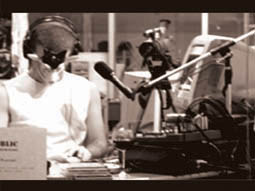Outcastings: DIY radio
Samara Mitchell

Jason Sweeney, Stereopublic
photo Aaron March
Jason Sweeney, Stereopublic
Stereopublic is an ongoing series of public radio performances conducted by Jason Sweeney, greeting audiences throughout Australia and Canada from café windows, footpaths and at Newcastle’s Electrofringe festival. Stereopublic combines broadcast media, spoken word, music and sound art, prodding at the invisible shoreline of the public domain which is perennially refashioned by the wavering ownership of intellectual property, social orthodoxy and censorship.
Stereopublic’s return to Adelaide has taken place in collaboration with the performance and new media company Para//elo. Over 4 days during September and October in the Lion Arts complex of Adelaide’s West End, the latest iteration of Stereopublic’s ‘happenings’ heralds the first manifestation of POP (Para//elo Open Platform), an experimental artists-assistance program, launched this year.
On the day I chose to visit, the performance space was set up much like a radio station: DJ’s soundproof glass cubicle replete with computers, microphones, a minidisk player and a large television looping images of local waterways. Sweeney was perched cheerily in his booth, a converted ground floor window of the Para//elo offices, mixing tracks from what I gathered to be the Brit-pop melancholia of SlowDive and maybe some Depeche Mode. I waved but didn’t drop in, discovering later that I was free to do so. Watching the foot-traffic of university students, skaters and office staff, I was pleased and bemused at this short-range transmission of music, OK Computer-esque bot monologues and weather reports unfolding for a small and preoccupied audience.
Amidst the random, abrasive and sometimes banal radio, Sweeney dropped in some John Cage moments of silence. Commercially owned media spaces dread dead airtime that can cost them thousands of dollars in lost advertising revenue. This fear highlights the power of unstructured spaces in the commercial arena. Membership-based media activists Adbusters recently fought a legal battle for the right to bring 30 seconds of silence to mainstream American television. Remarkably they won, planting a small but potent message for millions of television viewers.
Staring at the television screen as Sweeney delivered a repertoire of found texts, I experienced a brief moment of audiovisual Zen. Watching handheld footage of flotsam as it swam over ripples in a shallow pool, pinned by a tendril to the rotting pillar of a small wooden bridge. I was captivated by a senseless contentment. It may have been a non-existent bird that I heard pipe up as the wind scuffled across the minidisk’s microphone…soundscapes snagged in a trek alongside nearby riverbanks.
The audible presence of unseen running water and bird calls is both enigmatic and pacifying, letting you know that your surroundings are fruitful and secure. Of course there is savage appeal in the technique of softening aesthetes’ ears, before yelling in them. Jason Sweeney toys with his audience by volleying them between meditation tape nature-sounds and a punk aesthetic of abrasive signal testing. As the stormwater reports and sardonic news readings progressed, I was alert enough to pick out some useful solutions for water run-off, discovering that it was National Water Week in the process.
Narrowcast media and public performance play an important part in the development of uncensored ‘do it yourself’ radio spaces, the content of which is driven by the audience and the performer alone. Stereopublic is gathering the strength and the wit to do this with increasing voracity. For the moment—and perhaps I’m missing the point—I don’t feel Stereopublic is publicly pervasive enough. I look forward to the refinement of visual materials that accompany Jason’s random radio outcastings and their synergy with each new performance location.
Stereopublic, Jason Sweeney, Para//elo, Lion Arts complex, Adelaide, Sept and Oct.
RealTime issue #52 Dec-Jan 2002 pg. 38






